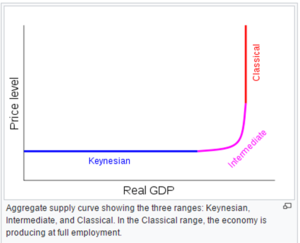Aggregate Supply
Aggregate supply (AS) is defined as the total amount of goods and services (real output) produced and supplied by an economy’s firms over a period of time. It includes the supply of a number of types of goods and services including private consumer goods, capital goods, public and merit goods and goods for overseas markets.[1]
Rising prices are usually signals for businesses to expand production to meet a higher level of aggregate demand. When demand increases amid constant supply, consumers compete for the goods available and therefore pay higher prices. This change in dynamic induces firms to increase supply output to sell more goods. The resulting supply increase causes prices to normalize and output to remain elevated. A shift in aggregate supply can be attributed to a number of variables. These include changes in the size and quality of labor, technological innovations, increase in wages, increase in production costs, changes in producer taxes and subsidies, and changes in inflation. Some of these factors lead to positive changes in aggregate supply, while others cause aggregate supply to decline. For example, increased labor efficiency, perhaps through outsourcing or automation, raises supply output by decreasing the labor cost per unit of supply. By contrast, wage increases - prevalent in many areas of the U.S. as of 2016 - place downward pressure on aggregate supply by increasing production costs.[2]

source:Wikipedia
There are two main reasons why the amount of aggregate output supplied might rise as P rises, i.e., why the AS curve is upward sloping:
- The short run AS curve is drawn given some nominal variables such as the nominal wage rate, which is assumed fixed in the short run. Thus, a higher price level P implies a lower real wage rate and thus an incentive to produce more output. In the neoclassical long run, on the other hand, the nominal wage rate varies with economic conditions. (High unemployment leads to falling nominal wages which restore full employment.) Hence in the long run the aggregate supply curve is vertical.
- An alternative model starts with the notion that any economy involves a large number of heterogeneous types of inputs, including both fixed capital equipment and labor. Both main types of inputs can be unemployed. The upward-sloping AS curve arises because
- (1) some nominal input prices are fixed in the short run and
- (2) as output rises, more and more production processes encounter bottlenecks.
At low levels of demand, there are large numbers of production processes that do not use their fixed capital equipment fully. Thus, production can be increased without much in the way of diminishing returns and the average price level need not rise much (if at all) to justify increased production. The AS curve is flat. On the other hand, when demand is high, few production processes have unemployed fixed inputs. Thus, bottlenecks are general. Any increase in demand and production induces increases in prices. Thus, the AS curve is steep or vertical.
Aggregate supply is targeted by government "supply side policies" which are meant to increase productive efficiency and hence national output. Some examples of supply side policies include: education and training, research and development, supporting small/medium entrepreneurs, decreasing business taxes, making labor market reforms to diminish frictions that may hold down output, and investing in infrastructure.[3]
References
- ↑ Aggregate supply Definition Economics Online
- ↑ BREAKING DOWN Aggregate Supply investopedia
- ↑ Aggregate Supply AnalysisWikipedia
Further Reading
- Aggregate Supply in the Economy: Definition and Determinants study.com
- Aggregate Supply and Depression Economics NY Times/Krugman
